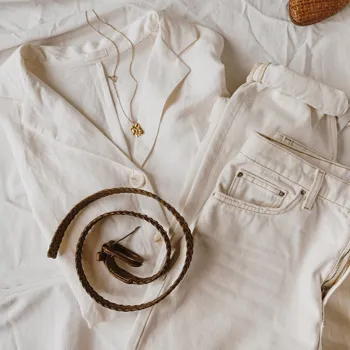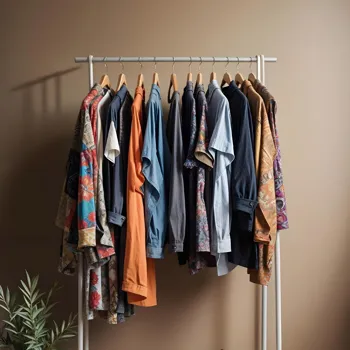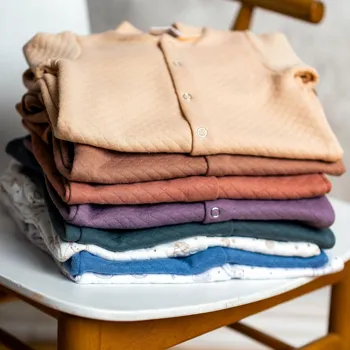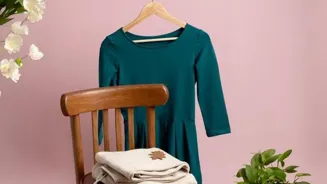Discover how to make your wardrobe eco-friendly, Indian style. Learn simple steps to sustainable fashion. Read on!
Fashion, fashion everywhere! It's on our phones, in our movies, and all over the streets
of bustling Indian cities. But behind those dazzling clothes and stylish trends lies a big question: what’s the impact of our fashion choices on ‘Mother Earth’?

The good news is, looking good doesn't have to cost the planet. You can absolutely incorporate sustainability into your fashion choices, step-by-step, making a real difference.
It's about being more mindful, more conscious – creating a wardrobe that's not only stylish but also has a positive story to tell. So, grab a cup of chai, and let's explore some easy and effective ways to create a more sustainable closet.
Declutter and Re-discover: Your Existing Wardrobe is a Goldmine!
Before you even think about buying anything new, dive deep into your existing wardrobe. We all have those 'hidden gems' – clothes we bought on a whim, wore once, and then forgot about. Take everything out, try it on, and be honest with yourself. Does it still fit? Do you still love it?

Is it damaged beyond repair? Create three piles: Keep, Donate/Sell, and Recycle/Upcycle. For the 'Keep' pile, think about how you can style things differently. That old saree? Maybe it can be transformed into a gorgeous kurta. That plain white shirt?
Dress it up with a colorful dupatta and some statement earrings. The point is to rediscover the potential within your existing collection. You'll be surprised at what you find.
The pieces you choose to keep can also be styled differently.
A formal shirt can become a casual one with rolled-up sleeves and jeans. So, give those old clothes a different look, style it differently and flaunt it. Always remember that reducing consumption is good for the enviornment.
Before you shop, think of the styles and trends in the existing wardrobe and use them effectively.
Embrace Quality Over Quantity: Invest in Pieces That Last.
Fast fashion is tempting, with its affordable prices and ever-changing trends. But those cheap clothes often end up in landfills after just a few wears. Instead of buying multiple flimsy items, invest in a few well-made, timeless pieces that will last for years.
Think classic cuts, durable fabrics like organic cotton and linen, and versatile colors that can be easily mixed and matched. Look for brands that are transparent about their production processes and committed to ethical labor practices.
While these items might cost a bit more upfront, they'll save you money in the long run because you won't have to replace them as often. They also look far better than the clothes that are relatively cheaper.
Look for durable and long lasting designs which can be worn for years.
Always focus on buying materials and designs that are timeless and good to wear for many years. The main purpose should be that the clothes should last longer and they're durable enough. The classic pieces are always better to buy with respect to styles, quality and durability.
Shop Mindfully: Ask Questions Before You Buy.
Before you give in to that shopping urge, pause and ask yourself a few important questions. Do I really need this? Where was it made? What is it made of? Is it ethically produced?

Look for certifications like Fair Trade and GOTS (Global Organic Textile Standard) that ensure fair labor practices and environmentally friendly production. Support local artisans and small businesses that prioritize sustainability.
Consider buying second-hand clothing from vintage stores or online platforms. This reduces textile waste and gives pre-loved garments a new lease on life. Remember, every purchase is a vote – a vote for the kind of fashion industry you want to support.
Always remember to ask if the new product is made of recycled materials, if it is made under fair labour conditions and what the enviornmental impacts of the product are. Always think before buying anything new. Shopping mindfully is a great way to contribute to the enviornment.
It helps with reducing your consumption and it helps in waste management.
Explore Sustainable Fabrics: Natural, Recycled, and Innovative.
The fabric your clothes are made of has a significant impact on the environment. Opt for natural, sustainable fabrics like organic cotton, linen, hemp, and silk. These materials are biodegradable and require fewer resources to produce compared to synthetic fabrics like polyester and nylon.
Explore innovative fabrics made from recycled materials, such as recycled plastic bottles or discarded fishing nets. These fabrics help reduce waste and give new life to materials that would otherwise end up in landfills. Look out for newer options too, such as fabrics made with sustainable dyes.
When buying for sustainable fabrics look for natural fibres, recycled fibres, innovative plant based materiels and fibres that have closed loop production process.
Natural fibres like organic cotton, linen, hemp and bamboo are produced without harmful chemicals, and recycled fabrics are made from recycled plastic. Sustainable fibers can minimize environmental waste and help improve carbon footpring.
Repair and Upcycle: Give Your Clothes a Second Chance.
Instead of throwing away damaged clothes, learn to repair them. Simple sewing skills like patching holes and replacing buttons can extend the life of your garments significantly. Get creative with upcycling! Turn old jeans into shorts, T-shirts into tote bags, or sarees into cushion covers.
There are tons of DIY tutorials available online to inspire you. Embrace the beauty of imperfection – a visible patch or a handcrafted embellishment can add character and personality to your clothes. Repair and upcycling can save a lot of money over time.
There are numerous ways to repair and upcycle your clothes. If you don't have the skill of sewing then get it done from a professional and save your old clothes. Try to repurpose your outfits and give a newer look and style to it. So, that you can wear it with different styles.
This will reduce the fashion waste.
Care for Your Clothes Properly: Wash Less, Wash Smart.
How you care for your clothes can also impact their lifespan and the environment. Wash your clothes less often – only wash them when they're actually dirty. Use cold water and eco-friendly detergents. Avoid using the dryer, as it consumes a lot of energy. Instead, hang your clothes to dry naturally.

Proper garment care not only extends the life of your clothes but also reduces your environmental footprint. So, care about your clothes so that it can last longer. It helps reducing waste and gives you satisfaction of wearing the same piece for longer period.
Wash your clothes only when necessary.
Use cold water and natural detergents. Avoid using the dryer as it consumes lots of energy. Proper care of your clothes can extend the life of clothing and its fabrics. Air dry your clothes whenever possible. This will save energy and it is gentle on clothes.










